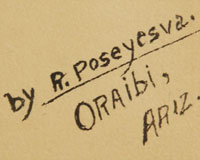Untitled Painting of a Tunei-nili Katsina [SOLD]
+ Add to my watchlist Forward to Friend
- Category: Paintings
- Origin: Hopi Pueblo, Hopituh Shi-nu-mu
- Medium: watercolor
- Size:
13-¼” x 9-3/4” image;
19-1/8” x 15” framed - Item # C4059.04 SOLD
Little is known about Hopi painter Raymond Poseyesva (1901-1953). He’s mentioned briefly in a few major Indian painter biographical directories, but very little information is presented. That he was born at Shungopovi and that he mostly painted Katsinam are the only facts published within these texts. Census information allowed enterprising dealers to ascertain his birth year, death year, and occupations: farmer and painter.
Poseyesva was one of the early group of Hopi flat-style painters. Among his contemporaries were Fred Kabotie, Waldo Mootzka, and Otis Polelonema. Though he is not as well known as these artists, he is highly regarded by collectors for his unique take on the traditional style.
Barton Wright’s book Kachinas: A Hopi Artist’s Documentary deftly explains the function of the Tunei-nili, the Katsina pictured in this painting: “Tunei-nili is a Navajo-derived Kachina. He is the individual who looks after the Navajo or Tasap Kachinas and is usually called a side dancer for them. However, he may not always appear with the Tasap. He was inspired by the Navajo Rain Gods, the Tone-nili, who appear on the sixth day of the Navajo Yeibichai Ceremony. The name Tunei-nili Bitzai means ‘little wash’ or ‘little river grandfather.’ He sometimes appears with the Velvet Shirt Kachinas also.” Poseyesva’s depiction of the Tunei-nili is quite similar to the one featured in the aforementioned book. Its mask, in particular, with its black ovular eyes turned diagonally in towards each other, is easily recognizable as that of the Tunei-nili. Poseyesva’s style differs from that of his contemporaries, most notably in the linework. While his peers used detailed linework to define their Katsinam, he instead used texture, shadow and subtle shading within simpler outlines. Here, the colors do the talking, and they do so gracefully.
Poseyesva’s depiction of the Tunei-nili is quite similar to the one featured in the aforementioned book. Its mask, in particular, with its black ovular eyes turned diagonally in towards each other, is easily recognizable as that of the Tunei-nili. Poseyesva’s style differs from that of his contemporaries, most notably in the linework. While his peers used detailed linework to define their Katsinam, he instead used texture, shadow and subtle shading within simpler outlines. Here, the colors do the talking, and they do so gracefully.
The painting is signed “R. Poseyesva - Oraibi, Ariz.” in its lower right corner and framed in a simple, beautiful wood frame.
Condition: this Untitled Painting of a Tunei-nili Katsina is in good condition with minor stains and discolorations
Provenance: from the large collection of a Santa Fe resident who is downsizing
Recommended Reading: Kachinas: A Hopi Artist’s Documentary by Barton Wright

- Category: Paintings
- Origin: Hopi Pueblo, Hopituh Shi-nu-mu
- Medium: watercolor
- Size:
13-¼” x 9-3/4” image;
19-1/8” x 15” framed - Item # C4059.04 SOLD



